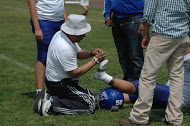Angélica Martínez/Creative Commons
If you were to go on Google News right now (at 5:30 on Tuesday), two of the main headlines deal with injuries to prominent players in professional headlines.
One is about San Francisco 49ers wide receiver Michael Crabtree being cleared to play after five and a half months sidelined with an achilles tendon tear.
On the other side of the spectrum, the other headlines concerned Green Bay Packers quarterback Aaron Rodgers leaving the weekend game with a broken collarbone.
Every week, I go on to ESPN to look at my fantasy team and I see that at least half of my team is listed as either probable or questionable. I figured that it was just my unusually unlucky team, but when I looked at the rest of the league, I saw that every other team was in the same boat.
Ninety percent of the time, my players are good to go by game time, and they end up having a solid week. But this makes me wonder how these players, and the league as a whole, would be different if they were consistently playing at 100 percent.
Have these players gotten really good at performing well at 50 percent or would they all be playing at the level of Peyton Manning when they’re at 100 percent?
Injuries are just a part of the game. Of course there are some injuries that pale in comparison to others. Nobody can say that the injury that Louisville’s Kevin Ware sustained was commonplace. There was nothing common about it. But for injuries, such as Rodgers’ broken collarbone, we almost expect him to bounce back quickly and be the same player that he was before.
There are a couple reasons why that mindset is both physically and mentally hurtful. Rodgers has said that he forsees his recovery time to be on the short end of the of the prognosis.
We’ve seen with the likes of Rob Gronkowski, that perhaps returning back to the field before an injury is fully healed can lead to even more harm coming to the player. It’s the fans and the media’s expectations that drive some of these players to go back to playing before maybe it would be advised by professionals.
On the same token, it can also sends a bad message to the children who are looking at these athletes as role models. Kids can rush their recoveries since they’ve seen some of their favorite athletes bounce back from a similar injury in less time.
There’s also the question of why professional athletes seem to be even more susceptible to injuries than younger players. Is it because they’re older and their bodies are more run down, or is it because the game is a lot rougher or could it even be a mixture of the two?
I think that the healing time is quicker when you’re younger, but the injuries are also going to be less severe. Head injuries are common regardless of the age of the player, but there seem to be more niggling little injuries to the professional athletes.
When I used to play, the only thing that would keep someone on my team out of a game was something serious like an ACL tear, concussion or a broken limb.
I remember a while ago when Ladanian Tomlinson was out for weeks with turf toe. Obviously, not being a football player, I probably don’t understand the trials and tribulations of turf toe, but it doesn’t feel like it would be on a similar level as a concussion or torn muscle.
Injuries aren’t a preventable part of sports. It’s the nature of sports to be physical and intense. It’s highly unlikely that you could go through years of playing sports without an injury.
What is preventable is racing back from the injury before it has had a chance to heal. With all the talk of concussions recently, letting injuries heal has become even more important to league officials.
Despite the best efforts of doctors, physical therapists and league officials, there is no way to stop an athlete from taking risks that might not be advisable for the athlete’s health.
I’ve seen plenty of athletes play on the shorter end of the recovery period, and the consequences have been severe. An injury that at once could have been healed with rest and a couple of weeks on the sidelines, now can only be repaired with surgery and years of physical therapy. Even at the end of the recovery period, they still may live with issues from the injury in their everyday life.
In the next few years, as the athletes of today age, there is certain to be a rise in people with arthritis and joints in need or repair.
Injuries do not get the care that are necessary for proper healing. If athletes would take the weeks off in stride, they may get more years out of their career than they would by rushing back into the fray.


Leave a Reply